Abstract
Organic charge-transfer cocrystals (CTCs) have attracted significant research attention due to their wide range of potential applications in organic optoelectronic devices, organic magnetic devices, organic energy devices, pharmaceutical industry, etc. The physical properties of organic charge transfer cocrystals can be tuned not only by changing the donor and acceptor molecules, but also by varying the stoichiometry between the donor and the acceptor. However, the importance of the stoichiometry on tuning the properties of CTCs has still been underestimated. In this review, single-crystal growth methods of organic CTCs with different stoichiometries are first introduced, and their physical properties, including the degree of charge transfer, electrical conductivity, and field-effect mobility, are then discussed. Finally, a perspective of this research direction is provided to give the readers a general understanding of the concept.
1. Introduction
Organic charge-transfer cocrystals (CTCs) is a new type of molecular crystal which is composed of organic donor and acceptor, in which electrons can transfer from the donor to the acceptor molecules [1,2,3,4,5,6,7,8]. Since quinhydrone as the first CTC was reported in 1844 [9], only the high conducting tetrathiafulvalene-tetracyanoquinodimethane (TTF-TCNQ) began to attract considerable attention due to the wide range of applications in organic optoelectronics [10,11,12,13,14]. Furthermore, the balanced ambipolar charge transport properties of dibenzotetrathiafulvalene-tetracyano-quinodimethane (DBTTF-TCNQ) also opened a door for organic co-crystal electronics [15,16]. Recently, organic CTCs have received intensive attention due to their tunable physical properties, ranging from insulators to conductors, and some potential applications in various fields have also been reported, such as the pharmaceutical industry [17,18,19], bio-electrochemical energy transfer process [20], optoelectrical devices [21,22], surface chemistry [23], non-linear optical materials [24], multiferroicities [4,25] as well as energy and solar energy storage [21,26,27]. As a recently studied topic, organic CTCs can be applied as active semiconducting layers in field-effect transistors, in which n-type, p-type, and ambipolar (the charge carrier is both electrons and holes) charge transport properties are experimentally observed [28,29,30].
In general, the physical properties of organic CTCs can be tuned by three approaches. The first method involves the variation in the donor/acceptor molecular structures. Compared to inorganics, the changing of the donor/acceptor molecule is similar to the changing anions/cations in inorganics. For example, NaCl and KCl have different properties due to the difference of cations in inorganics. Organic CTCs, systems such as TTF-TCNQ and perylene-TCNQ exhibit different electrical conductivity properties due to the difference of the donor molecules [6,13]. The second alternative approach is to control the polymorphs. It indicates that the crystals have the same chemical formula but have different molecular crystal structures. For instance, CaTiO3 has a cubic structure at high temperatures and orthorhombic symmetry at low temperatures [31]. The same feature can be observed in organic CTCs, for example, perylene-TCNQ exhibits two phases [32]: α phase with monoclinic symmetry (at room temperature) and γ phase with triclinic symmetry (below 210 K). Finally, the stoichiometry between the donor and the acceptor is a particularly important factor in determining the physical properties of a given organic CTCs. In inorganics, the stoichiometry is determined by the oxidation state of elements. For example, owing to the different oxidation states of Hg, HgCl2 and Hg2Cl2 have varied stoichiometries between Hg and Cl, which reveal quite different physical and chemical properties [33]. In organic CTCs, the stoichiometry between the donor and the acceptor can also play an important role in controlling the physical properties [34,35,36]. For example, perylene-TCNQ with the stoichiometry of 1:1 (P1T1) shows n-type semiconducting behavior with electron mobility of 10−3 cm2 V−1 s−1, while perylene-TCNQ with the stoichiometry of 3:1 (P3T1) exhibits p-type semiconducting results with a hole mobility of 10−4 cm2 V−1 s−1 [37]. It reveals that the charge transport type and performance can be tuned via the variation of the stoichiometry between the donor and the acceptor.
The degree of charge transfer (DCT) reveals the number of charges transferred from the donor to the acceptor [38,39,40]. The change of the stoichiometry can affect the DCT of organic CTCs. Thus, the DCT is introduced to evaluate the physical properties of CTCs. The DCT can be determined from the bond length variation in the charge transfer process by single X-ray diffraction (XRD) measurement or the wavenumber changes of certain vibration modes by infrared (IR) spectroscopy or Raman spectroscopy measurements [6,41,42].
There are many papers related to charge transfer cocrystals published in several special issues of the journal Crystals covering different aspects, including donor-acceptor packing type of co-crystals [43,44], hydrogen-bonded co-crystals [45,46], conducting and superconducting co-crystals [47,48], etc. However, it is still worth discussing the role of stoichiometry between donor and acceptor in co-crystals. Among the abovedescribed three methods, it is still difficult to precisely control the stoichiometry between the donor and the acceptor via the designed experiments, although a few related cases have been reported. Thus, this short review summarizes the change in the stoichiometry of organic CTCs, which is mainly based on the work of our group, in order to provide the readers with a comprehensive understanding of the concept. First, single-crystal growth methods for growing organic CTCs with different stoichiometries are discussed, and their physical properties, in particular, DCT and electronic properties, are then discussed in detail. TCNQ-based organic CTCs have been widely investigated in the last few decades; therefore, herein we limit ourselves to consider the TCNQ-based organic CTCs. The discussed organic donors and acceptors for the formation of organic CTCs are presented in Figure 1. Finally, a general perspective of this direction is provided.
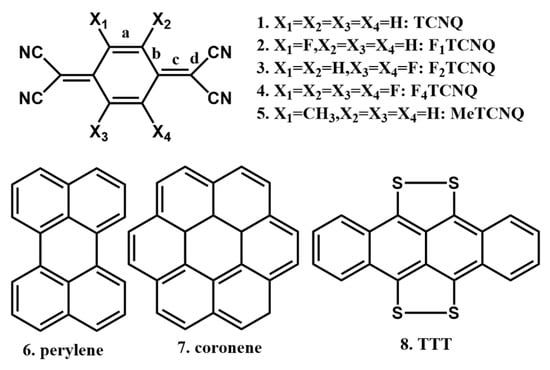
Figure 1.
Molecular structures of organic donors and acceptors for the formation of charge-transfer cocrystals discussed in this review.
2. Single-Crystal Growth of Organic Charge-Transfer Cocrystals with Different Stoichiometry
In general, controlling the molar proportion of the starting materials is a semi-empirical way to obtain organic CTCs with different stoichiometries, and in some cases, it works while it does not succeed in many other cases. In a practical scenario, it is actually difficult to know which experimental parameters will affect the stoichiometry of organic CTCs during the co-crystallization process. Therefore, it is necessary to analyze the single-crystal growth of organic CTCs, in order to analyze the function of the cocrystallization parameters in detail. Herein, three main cocrystallization methods are introduced: solid-state grinding method, solution-based method, and gas-phase method [49,50,51,52].
In the pharmaceutical industry, solid-state grinding is commonly employed as an efficient way to screen new organic CTCs. The solid-state grinding consists of two techniques: neat grinding and liquid assisted grinding. The difference between the two methods is that a small amount of an additional liquid is added to the grinding mixture for liquid assisted grinding. For example, Tothadi et al. [53] reported the synthesis of isonicotinamide and dicarboxylic acid CTCs (Figure 2a) by the liquid-assisted grinding method.
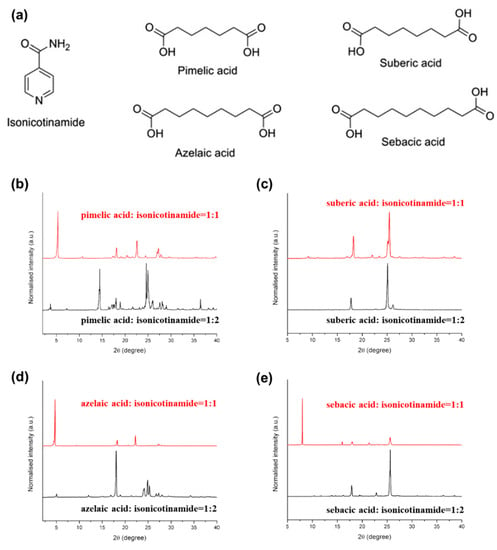
Figure 2.
(a) Isonicotinamide and coformers (dicarboxylic acids) used for cocrystallization; (b) Powder X-ray diffraction (PXRD) of pimelic acid: isonicotinamide (red) (1:1) crystals and (black) (1:2) crystals; (c) PXRD of suberic acid: isonicotinamide (red) (1:1) crystals and (black) (1:2) crystals; (d) PXRD of azelaic acid: isonicotinamide (red) (1:1) crystals and (black) (1:2) crystals; (e) PXRD of sebacic acid: isonicotinamide (red) (1:1) crystals and (black) (1:2) crystals. Data are reproduced with permission from [53].
In the beginning, the donors and the acceptors were taken in the required stoichiometric ratio (1:1 or 2:1) and were ground after adding 2–3 drops of EtOH. Then, the ground powder was dissolved in a minimum amount of hot methanol (MeOH). After evaporation of the solvent for several days, the final CTCs with different stoichiometries were obtained. The powder XRD patterns show that the obtained CTCs with varied stoichiometries have a distinct phase for the four systems (Figure 2b–e). The alkali-TCNQ and some TTF-based CTCs can be synthesized by such methods, such as Cu-TCNQ [54], Rb2-(TCNQ)3-I2 [55], TTF-chloranil [56], etc.
Solid-state grinding is quite efficient in finding new CTCs with different stoichiometries by changing the starting ratio of the donors and the acceptors. However, it is not easy to obtain large crystals and it always needs post-treatment (such as solution-based method) to obtain single crystals.
The following four solution-based methods (Figure 3) can be employed to grow organic CTCs: slowing cooling method (Figure 3a), slow solvent evaporation method (Figure 3b), vapor diffusion method (Figure 3c) and liquid-liquid interface diffusion method (Figure 3d). For the first three methods, the donors and the acceptors are mixed together and then are dissolved in a certain solvent or mixed solvent. Once the charge transfer between the donor and the acceptor occurs, the CTCs can nucleate and then grow larger in size by decreasing the temperature or evaporating the solvent of the saturated CTCs solution. If the donors and the acceptors are dissolved separately in the two immiscible solvents, the CTCs single crystals can be achieved at the interfaces.

Figure 3.
Solution-based methods for the single-crystal growth of organic charge-transfer cocrystals (CTCs): (a) slowing cooling method; (b) slow solvent evaporation method; (c) vapor diffusion method; (d) liquid-liquid interface diffusion method.
Organic CTCs can also be grown by simply mixing the donor and acceptor and simultaneously dissolving them in one or a mixed solvent. In the perylene-TCNQ system, the (perylene)1-(TCNQ)1 single crystals were prepared by slowly evaporating the chloroform solution with an equimolar ratio of perylene and TCNQ [57]. The (perylene)3-(TCNQ)1 single crystals were obtained by slowly evaporating the benzene solution with a different molar ratio of 3:1 between perylene and TCNQ [58].
However, in some special situations, the final stoichiometry of organic CTCs is not dependent on the molal proportion of the starting mixed donors and acceptors [59]. Our group previously found that the single-crystal growth of (perylene)1-(TCNQ)1 (P1T1) and (perylene)3-(TCNQ)1 (P3T1) by the slow cooling method exhibited solvent dependence on the stoichiometry (Figure 4a). Irrespective of the initial mixed molal proportion between perylene and TCNQ, the P1T1 single crystals are formed only from the toluene solvent, while the P3T1 single crystals are obtained solely from benzene solution. Single crystals of P1T1 are needle-like, while P3T1 crystals are cube-like. Thus they can be easily distinguished based on morphology (Figure 4b,c). The precipitation−dissolution equilibrium theory was employed to explain the phenomenon. The results indicate that the stoichiometry of the single-crystal growth is governed by the solubility of the CTCs. The solubility of P1T1 is larger than that of P3T1 in benzene and smaller than that of P3T1 in toluene (Figure 4d). Consequently, the P1T1 first precipitates in toluene, and P3T1 firstly precipitates in benzene. All the possible equilibria with regard to the single-crystal growth routes are shown in Figure 4e. In toluene, even if the P3T1 cocrystals are formed first, the P1T1 cocrystals are finally obtained due to their low solubilities. It is for the same reason that P3T1 cocrystals precipitate in benzene.
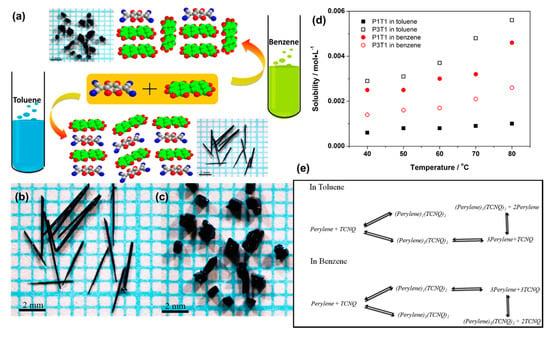
Figure 4.
(a) Single-crystals growth of (perylene)1-(TCNQ)1 and (perylene)3-(TCNQ)1 by slow cooling method exhibits a solvent-dependent on the stoichiometry; (b) Optical images of (perylene)1-(TCNQ)1 single crystals from toluene; (c) Optical images of (perylene)3-(TCNQ)1 single crystals from benzene; (d) The solubilities of (perylene)3-(TCNQ)1 and (perylene)1-(TCNQ)1 in toluene and benzene at different temperatures (mol/L); (e) All possible equilibria in the perylene-TCNQ system. TCNQ: tetracyanoquinodimethane. Data are reproduced with permission from [59].
By using the solution method, it is easy to control the stoichiometry of the CTCs by controlling the ratio of starting materials, even though there are a few exceptions. Another advantage is that large, good quality crystals can be obtained. However, solvent molecules may get incorporated into the crystal structure, which prevents the preparation of the required CTCs [60].
Three gas-phase methods are used for the single-crystal growth of organic CTCs (Figure 5), depending on the sublimation temperatures of the starting materials. In one case, if the sublimation temperatures of organic donors and acceptors are nearly equal, the starting materials can be mixed together and put into a two-zone furnace with an argon gas flow for the single-crystal growth (Figure 5a). In another case, if the sublimation temperatures of organic donors and acceptors are dramatically different, the powders or single crystals of the starting materials with low sublimation temperatures can be placed at the left side of the furnace, and the powders or single crystals of the starting materials with high sublimation temperatures can be placed at the right side of the furnace. Then, under an argon gas flow, organic CTCs initially grow at the right end of the furnace (Figure 5b). Occasionally, if the sublimation temperatures of organic donors and acceptors are quite low, no time is allowed to nucleate organic CTCs in an open system. In this situation, a closed ampoule can be used for the single-crystal growth of organic CTCs. In detail, the sealed ampoule is placed into the two-zone furnace (Figure 5c). In the gas-phase growth process, the vapor pressure of the individual components is determined. In other words, the vapor pressure of the individual components determines the amount of donor/acceptor molecules sublimed to the single crystals zone, and further defines the stoichiometry of CTCs. Consequently, the stoichiometry of the final crystals is random.
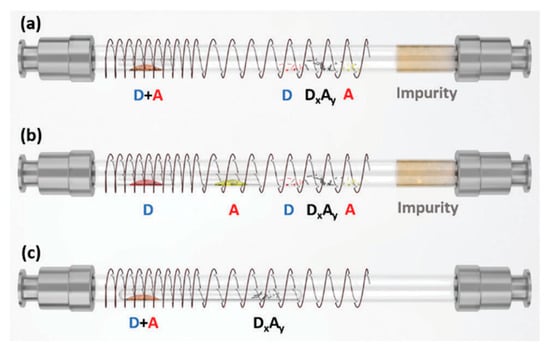
Figure 5.
Schematic for the single-crystal growth of organic charge-transfer cocrystals by the gas-phase methods: (a) Open system (mixed starting materials); (b) Open system (separated starting materials); (c) Close-system. ‘‘D’’ means donors. ‘‘A’’ means acceptors. ‘‘D + A’’ means the mixture of donors and acceptors. DXAY means an organic charge-transfer cocrystal with the stoichiometry of X:Y. Data are reproduced with permission from [6].
In perylene-TCNQ systema, single crystals of both the monomolecular (perylene and TCNQ) and the three perylene−TCNQ CTCs [(perylene)1-(TCNQ)1, P1T1; (perylene)2-(TCNQ)1, P2T1; (perylene)3-(TCNQ)1, P3T1] are grown simultaneously by the gas-phase method (Figure 6).
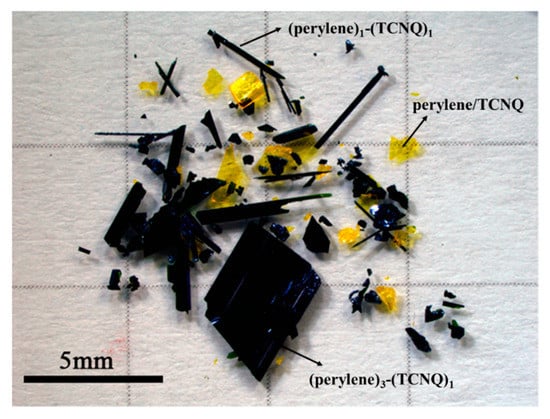
Figure 6.
A typical mixture of phases grown in an open gas-phase single-crystal growth system with flowing argon gas. Data are reproduced with permission from [37].
Thus, they can be easily distinguished based on their color and morphology. Both perylene and TCNQ single crystals show a yellow color, while thin CTCs exhibit a green color, and thick CTCs display a dark-green or black color. Moreover, it was also possible to visually distinguish needle-like P1T1 crystals from platelet-shaped P2T1 and P3T1 crystals. However, only by single XRD or Raman spectroscopy, the P2T1 and P3T1 single crystals can be differentiated from each other. Obviously, by using the gas-phase growth method, the contamination of the solvent can be easily avoided. Nevertheless, the stoichiometry of the final CTCs can not be controlled.
Besides the perylene-TCNQ system, there are limited reports on the different stoichiometry CTCs with the same donor and acceptor for TCNQ-based systems, such as the TTT (tetrathiotetracene)-TCNQ system [61], and the coronene-TCNQ system [62]. The single-crystal growth parameters of different CTCs systems are summarized in Table 1.

Table 1.
Single crystal growth parameters of different CTCs systems.
3. Electronic Properties of Charge-Transfer Cocrystals with Different Stoichiometry
3.1. The Degree of Charge Transfer
As mentioned in the Introduction section, DCT reveals the amount of charge transferred from the donor to the acceptor. The geometry of the donor or the acceptor may vary when the charge transferred [72]. Consequently, DCT can be estimated by calculating the variation in the bond length. In TCNQ or fluorinated TCNQ CTCs, the length of some bonds is especially sensitive to the negative charge on molecules [73,74,75]. It means that the bond lengths are changed when the acceptor shows an increasing negative charge. The population of electrons in TCNQ or fluorinated TCNQ leads to the increase in the length of two bonds (a and c), while decreasing the length of the other two bonds (b and d) (Figure 1) [76,77]. Therefore, DCT can be estimated by single-crystal XRD. The equations used for calculations are represented below [41,42,67]:
where DCT is the degree of charge transfer, , b, c, and d are the bond lengths of TCNQ molecules in neutral TCNQ, TCNQ anion, and charge transfer compound, respectively (Figure 1). The subscripts CT, −1, and 0 refer to the charge transfer compound, the anion, and the neutral molecular, respectively.
Furthermore, spectrophotometry is another convenient method to determine the DCT. When the charge has transferred from donor to acceptor, the intensities of molecular vibration bands get enhanced. Thus, the certain vibration mode of the CTCs in IR spectroscopy and Raman spectroscopy can be used to calculate the DCT. The corresponding equation is shown below [38,41,42,67,72]:
where . The , and represent certain stretching modes of pure TCNQ molecules, charge transfer compound, and TCNQ anion, respectively.
In TCNQ or fluorinated TCNQ CTCs, the C=C in-plane stretching mode (Ag symmetry) [37,67,78] and the C≡N stretching mode (b1u symmetry) [67,79] are always used to determine the degree of charge transfer. The detection C=C in-plane stretching mode is convenient by Raman spectroscopy, and that of the C≡N stretching mode is convenient by IR spectroscopy. Figure 7 shows typical IR and Raman spectra of CTCs for calculating the DCT. For the pristine 2-fluoro-7,7,8,8-tetracyanoquinodimethane (F1TCNQ), 2,5-difluoro-7,7,8,8-tetracyanoquinodimethane (F2TCNQ), and 2,3,5,6-tetrafluoro-7,7,8,8ν-tetracyanoquinodimethane (F4TCNQ), the peak for C=C in-plane stretching mode is observed at 1452 cm−1. After the charge gets transferred from perylene to F1TCNQ, F2TCNQ, and F4TCNQ, the peak downshifts by 11, 15, and 21 cm−1 for perylene-F1TCNQ, perylene-F2TCNQ, and perylene-F4TCNQ, respectively (Figure 7a,b). For the C≡N stretching mode, the peaks of pristine F1TCNQ, F2TCNQ, and F4TCNQ are located at 2223, 2230, and 2230 cm−1, respectively. After obtaining electrons from perylene, the peaks are redshifted to 2221, 2225, and 2221 cm−1 for perylene-F1TCNQ, perylene-F2TCNQ, and perylene-F4TCNQ, respectively (Figure 7c–e). Then, by using the equation mentioned above, the degree of charge transfer can be easily estimated.

Figure 7.
Infrared (IR) and Raman spectra of perylene-F1TCNQ, perylene-F2TCNQ, and perylene-F4TCNQ: (a) Raman spectra of pristine F1TCNQ, F2TCNQ, and F4TCNQ; (b) Raman spectra of perylene-F1TCNQ, perylene-F2TCNQ and perylene-F4TCNQ; (c) IR spectra of perylene-F1TCNQ compared with pristine F1TCNQ; (d) IR spectra of perylene-F2TCNQ compared with pristine F2TCNQ; (e) IR spectra of perylene-F4TCNQ compared with pristine F4TCNQ. Data are reproduced with permission from [67].
Even though the absolute value of the DCT is different for the three methods, the existence of some trends between the stoichiometry and the DCT can still be concluded. Table 2 lists the DCT for some TCNQ and fluorinated TCNQ based organic CTCs systems. In most cases, with the increase of donor numbers, the DCT increases. In other words, more than one donor contributes charges to one acceptor, which results in the increment of the DCT. For example, in the perylene-TCNQ system, the DCT increases from 0.01 to 0.23 attributed to the increase in the number of perylene molecules from 1 to 3 in the unit cell [37]. However, in perylene-F1TCNQ, perylene-F2TCNQ, and perylene-F4TCNQ systems, the ratio between organic donors and acceptors is not an integer, which leads to nearly the same DCT [66,80]. For the 1:1 stoichiometry CTCs, the DCT increases dramatically with the increment of the number of F atoms. It is due to not only the strong electron affinity of fluorine atoms [67], but also the incorporation of strong C–H⋯N and C–H⋯F interaction [41]. For example, a strong C−H⋯F interaction results in a larger contributions to the DCT (0.46 ± 0.04) in naphtho[1,2-b:5,6-b’]dithiophene (NDT)-1,3,4,5,7,8-hexafluorotetracyanonaph-thoquinodimethane (F6TNAP) system [41].

Table 2.
The degree of charge transfer in some TCNQ and fluorinated TCNQ CTCs systems.
3.2. The Electrical Conductivity and Field-Effect Mobility
Table 3 presents the conductivity of some TCNQ based organic CTCs with different stoichiometry. The analyzed data indicate that the conductivity has no relationship with the stoichiometry. In the perylene-TCNQ system, the CTCs with different stoichiometry show semiconducting properties with relatively low conductivity. However, the TTT-TCNQ CTCs exhibit quite high conductivity. Several reports indicate that the observed different conductivities are due to the different molecular packing in these organic CTCs systems [2,4,81,82].

Table 3.
The conductivity of some CTCs with different stoichiometry.
The schematic representation of organic CTCs with different molecular packing is shown in Figure 8a. In general, for 1:1 stoichiometry, there are two major molecular packings: mixed-stack and segregated-stack. In the mixed-stack systems, the donor and the acceptor molecules alternate (–D–A–D–A–) along the stacking direction and are parallel to each other. For example, in the anthracene-F4TCNQ system, anthracene and F4TCNQ molecules alternate not only along the b-direction, but also the c-direction (Figure 8b) [42]. However, in the segregated-stack systems, the donor and the acceptor molecules form adjacent separated (–A–A–A– and –D–D–D–) stacks, and the D and A columns are parallel to each other. TTF-TCNQ adopts this type of molecular stacking (Figure 8c) [6]. For 2:1 stoichiometry, three packing modes exist. First, more number of donors forms –D–D–A–D–D–A– packing along the stacking direction for mixed-stack system. Second, if existed in the segregated-stack systems, the donor and the acceptor molecules also form –A–A–A– and –D–D–D– stacks [84]. Finally, the donor and the acceptor molecules form –D–A–D–A– stacking along with the π-stacking orientations, and an additional donor molecule is inserted between the adjacent stacks. For example, in the P2T1 single crystals, one perylene molecule still undergoes face-to-face “π–π” stacking with nearby one TCNQ molecule and another perylene molecule undergoes “herringbone” packing between two –D–A–D–A–chains (Figure 8d) [37]. For 3:1 stoichiometry, the donor and the acceptor molecules form –D–D–A–D–D–A– stacking along the π-stacking orientations, and an additional donor molecule is inserted between adjacent stacks. In the P3T1 single crystals, two perylene molecules are located between each pair of TCNQ molecules, and a third perylene molecule is located between the perylene-TCNQ stacks (Figure 8e) [37]. In recent reports, the donor and acceptor can also form the 3:2 stoichiometry. There are two chains, and one chain adopts –D–A–D–A– stacking while another one takes –D–A–D–D–A–D– stacking (Figure 8f) [66]. It can be regarded as a mixed-stacking. In general, the mixed stacking system exhibits a lower conductivity, while the segregated stack normally generates a higher conductivity.
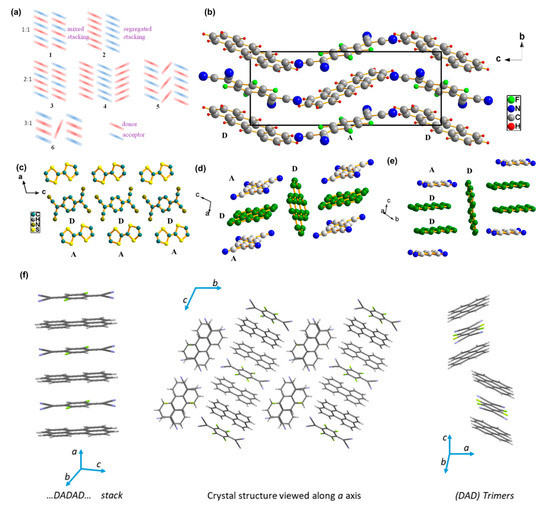
Figure 8.
(a) Schematic representations of CTCs with different molecular packing. The red and blue rectangles represent the donor and acceptor constituents, respectively; (b) Crystal packing of the tetracene-F4TCNQ along the (100) direction; (c) Crystal packing of the TTF-TCNQ; (d) Crystal packing of the (perylene)2-(TCNQ)1; (e) Crystal packing of the (perylene)3-(TCNQ)1; (f) Crystal packing of the (perylene)3-(F4TCNQ)2. (a) is reproduced with permission from [2]; (b) is reproduced with permission from [42]; (c) is reproduced with permission from [6]; (d,e) are reproduced with permission from [37]; (f) is reproduced with permission from [66].
The mobility and carrier type are also dramatically affected by the stoichiometry. There are quite limited reports on the effect of stoichiometry on the field-effect mobility. Thus, the perylene-TCNQ system is still considered as an example [37,65]. The typical transfer curves of P1T1, P2T1, and P3T1 are shown in Figure 9. Single crystals of P1T1 show n-type property with maximum mobility of 10−3 cm2 V−1 s−1. The P3T1 cocrystals show p-type performance, and the maximum mobility is ~10−4 cm2 V−1 s−1. Comparative analysis indicates that the P2T1 cocrystals show ambipolar properties with a hole mobility of 3 × 10−5 cm2 V−1 s−1 and electron mobility of 7 × 10−5 cm2 V−1 s−1. Noteworthy, when more perylene molecules contribute electrons to one TCNQ molecular, an n-type semiconductor becomes ambipolar and further becomes a p-type semiconductor. All the performances of the representative devices are presented in Table 4. The experimental results from the different research groups can get an agreement with the transport type, and the field-effect mobilities are higher or lower, depending on the different device fabrication techniques.

Figure 9.
Electrical characteristics of the perylene-TCNQ crystals. (a) (perylene)1-(TCNQ)1 with silver contacts (top contact); (b) (perylene)2-(TCNQ)1 with silver contacts (bottom contact); (c) (perylene)3-(TCNQ)1 with gold contacts (bottom contact). Data are reproduced with permission from [37].

Table 4.
Performance of single-crystal field-effect transistors based on (perylene)1-(TCNQ)1, (perylene)2-(TCNQ)1 and (perylene)3-(TCNQ)1.
Hirshfeld surface analysis is a good way to investigate the intermolecular interactions in the molecular crystal [76,85,86,87,88]. The distance from the surface to the nearest nucleus in another molecule is defined as distance external to the surface (de), while the distance from the surface to the nearest atom in the molecule itself is defined as distance internal to the surface (di). We take P1T1, P2T1, and P3T1 as examples to reveal the intermolecular interactions in the single crystals. The fingerprint plots visualizing de and di for C⋯C, C⋯H, C–H⋯N contacts (including reciprocal ones) generated for TCNQ in P1T1, P2T1, and P3T1 are shown in Figure 10. Meanwhile, the fingerprint plots visualizing de and di for C⋯C, C⋯H contacts (including reciprocal ones) generated for perylene in P1T1, P2T1, and P3T1 are shown in Figure 11. In all three charge transfer cocrystals, strong π-π stacking interaction between perylene and TCNQ molecules are illustrated by the green-yellow color around de = di ≈ 1.8 Å (Figure 10a1,b1,c1 and Figure 11a1,c1,e1). In P2T1 and P3T1, the perylene contains two different positions. One is along the π -stacking orientations, and another is inserted between adjacent stacks (Figure 8d,e). Thus, the inserted perylene did not exhibit strong π-π stacking interaction with the TCNQ molecules (Figure 11b1,d1). When the number of perylenes increased in the unit cell from P1T1 to P3T1, the extra C⋯H interactions can be observed, which indicated that TCNQ acted as an acceptor as shown in Figure 10a2,b2,c2). In P2T1 and P3T1, the perylene molecules contributed a strong C−H⋯π interactions. It is clearly seen that a “wings” in the fingerprint plots where de > di (Figure 11c2,e2). Furthermore, in all P1T1, P2T1 and P3T1 charge transfer cocrystals, TCNQ acts only as C–H⋯N acceptor, as shown by the characteristic spike where de < di (Figure 11a3,b3,c3).

Figure 10.
Fingerprint plots visualizing de and di for C⋯C, C⋯H, C–H⋯N contacts (including reciprocal ones) generated for TCNQ in P1T1 (a1,a2,a3), P2T1 (b1,b2,b3), and P3T1 (c1,c2,c3).
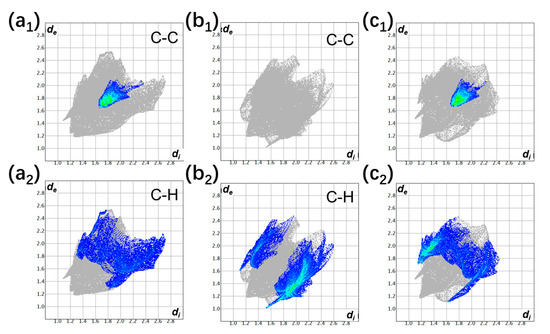
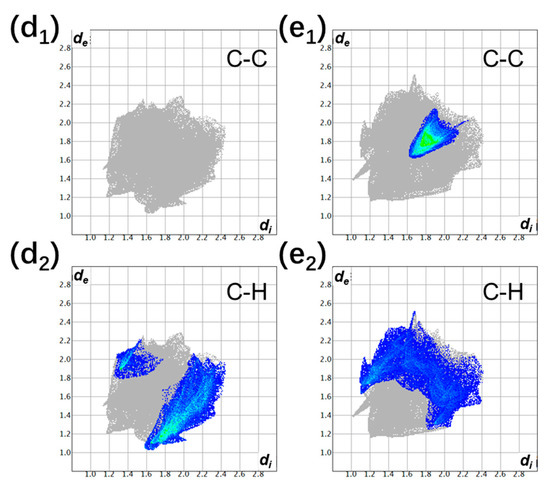
Figure 11.
Fingerprint plots visualizing de and di for C⋯C, C⋯H contacts (including reciprocal ones) generated for perylene in P1T1 (a1,a2), P2T1 (b1,b2,c1,c2), and P3T1 (d1,d2,e1,e2).
4. Conclusions
In summary, by presenting some representative organic charge-transfer co-crystal systems (CTCs), we have introduced the single-crystal growth methods and the physical properties of organic CTCs with different stoichiometries. The degree of charge transfer, conductivity, and field-effect mobility are discussed in detail. The stoichiometry of organic CTCs is a relatively new research topic, since there are still some experimental parameters that must be carefully controlled. The related research is still in its initial stage, which should be paid much attention to. The following key points should be developed in the future: (1) the single-crystal growth of organic CTCs with different stoichiometry by the gas phase is still random. However, by controlling the mixed proportion of the starting materials, the CTCs with the desired stoichiometry can be obtained by a solution method. However, in some special cases, the final stoichiometry of the CTCs is not dependent on the mixed molal ratio between the donor and the acceptor. Accordingly, the precise strategic design of the single-crystal growth of CTCs with different stoichiometry should be developed. (2) Furthermore, the degree of charge transfer is dramatically affected by stoichiometry. The DCT increased with the increase of donor numbers, which is due to the fact that more than one donor contributes charges to one acceptor. (3) The conductivity is related to the molecular packing, and not affected by the stoichiometry for organic CTCs. However, the mobility can be modulated by the stoichiometry of the CTCs
Despite some of the existing studies reviewed herein, the importance of the stoichiometry for organic CTCs is still underestimated. Thus, we hope this review would give some inspirations to look more into this topic and develop more systems to investigate the function of the stoichiometry in organic CTCs.
Author Contributions
P.H. and H.J. designed the project. J.G. and P.H. wrote the manuscript. H.Z. and H.J. assisted in manuscript writing. All authors commented on the manuscript. All authors have read and agreed to the published version of the manuscript.
Funding
This research was funded by the National Natural Science Foundation of China (No. 51803168) and the APC was funded by Nowthwest University. P.H. also acknowledges financial support from the Youth Innovation Team of Shaanxi Universities. H.Z. acknowledges financial support from the National Natural Science Foundation of China (11704311), Natural Science Foundation of Shaanxi Provincial Department of Education (17JK0772) and Natural Science Foundation of Shaanxi Province (2018JQ1069). H.J. acknowledges the grants from the National Research Foundation, Prime Minister’s Office, Singapore under its Campus of Research Excellence and Technological Enterprise (CREATE) programme.
Conflicts of Interest
The authors declare no conflict of interest.
References
- Jiang, H.; Hu, W. The Emergence of Organic Single-Crystal Electronics. Angew. Chem. Int. Ed. 2020, 59, 1408–1428. [Google Scholar] [CrossRef]
- Zhang, J.; Xu, W.; Sheng, P.; Zhao, G.; Zhu, D. Organic Donor-Acceptor Complexes as Novel Organic Semiconductors. Acc. Chem. Res. 2017, 50, 1654–1662. [Google Scholar] [CrossRef]
- Singleton, J. Why do physicists love charge-transfer salts? J. Solid State Chem. 2002, 168, 675–689. [Google Scholar] [CrossRef]
- Wang, Y.; Zhu, W.; Dong, H.; Zhang, X.; Li, R.; Hu, W. Organic Cocrystals: New Strategy for Molecular Collaborative Innovation. Top. Curr. Chem. 2016, 374, 83. [Google Scholar] [CrossRef] [PubMed]
- Hu, P.; Ye, J.; Jiang, H. Which isomer is better for charge transport: Anti- or syn-? J. Mater. Chem. C 2019, 7, 5858–5873. [Google Scholar] [CrossRef]
- Jiang, H.; Hu, P.; Ye, J.; Zhang, K.K.; Long, Y.; Hu, W.; Kloc, C. Tuning of the degree of charge transfer and the electronic properties in organic binary compounds by crystal engineering: A perspective. J. Mater. Chem. C 2018, 6, 1884–1902. [Google Scholar] [CrossRef]
- Sun, L.; Zhu, W.; Yang, F.; Li, B.; Ren, X.; Zhang, X.; Hu, W. Molecular cocrystals: Design, charge-transfer and optoelectronic functionality. Phys. Chem. Chem. Phys. 2018, 20, 6009–6023. [Google Scholar] [CrossRef] [PubMed]
- Sun, L.; Yang, F.; Zhang, X.; Hu, W. Stimuli-responsive behaviors of organic charge transfer cocrystals: Recent advances and perspectives. Mater. Chem. Front. 2020, 4, 715–728. [Google Scholar] [CrossRef]
- Wöhler, F. Untersuchungen über das Chinon. Justus Liebigs Ann. Chem. 1844, 51, 145–163. [Google Scholar] [CrossRef]
- Epstein, A.J.; Etemad, S.; Garito, A.F.; Heeger, A.J. Metal-Insulator Transition and Antiferromagnetism in a One-Dimensional Organic Solid. Phys. Rev. B 1972, 5, 952–977. [Google Scholar] [CrossRef]
- Odom, S.A.; Caruso, M.M.; Finke, A.D.; Prokup, A.M.; Ritchey, J.A.; Leonard, J.H.; White, S.R.; Sottos, N.R.; Moore, J.S. Restoration of Conductivity with TTF-TCNQ Charge-Transfer Salts. Adv. Funct. Mater. 2010, 20, 1721–1727. [Google Scholar] [CrossRef]
- Klots, C.E.; Compton, R.N.; Raaen, V.F. Electronic and ionic properties of molecular TTF and TCNQ. J. Chem. Phys. 1974, 60, 1177–1178. [Google Scholar] [CrossRef]
- Anderson, P.W.; Lee, P.A.; Saitoh, M. Remarks on Giant Conductivity in TTF-TCNQ. Solid State Commun. 1973, 13, 595–598. [Google Scholar] [CrossRef]
- Groff, R.P.; Suna, A.; Merrifie, R. Temperature-Dependence of Conductivity of Tetrathiafulvalene-Tetracyanoquinodimethane (TTF-TCNQ) Single-Crystals. Phys. Rev. Lett. 1974, 33, 418–421. [Google Scholar] [CrossRef]
- Wu, H.-D.; Wang, F.-X.; Xiao, Y.; Pan, G.-B. Preparation and ambipolar transistor characteristics of co-crystal microrods of dibenzotetrathiafulvalene and tetracyanoquinodimethane. J. Mater. Chem. C 2013, 1, 2286–2289. [Google Scholar] [CrossRef]
- Kobayashi, H.; Nakayama, J. The Crystal-Structure of the Charge-Transfer Complex of Dibenzotetrathiafulvalene-Tetracyanoquinodimethane, DBTTF-TCNQ. Bull. Chem. Soc. Jpn. 1981, 54, 2408–2411. [Google Scholar] [CrossRef]
- Karki, S.; Friščić, T.; Jones, W. Control and interconversion of cocrystal stoichiometry in grinding: Stepwise mechanism for the formation of a hydrogen-bonded cocrystal. CrystEngComm 2009, 11, 470–481. [Google Scholar] [CrossRef]
- Paul, M.; Chakraborty, S.; Desiraju, G.R. Six-Component Molecular Solids: ABC[D1–(x+y)ExFy]2. J. Am. Chem. Soc. 2018, 140, 2309–2315. [Google Scholar] [CrossRef]
- Mir, N.A.; Dubey, R.; Desiraju, G.R. Four- and five-component molecular solids: Crystal engineering strategies based on structural inequivalence. IUCrJ 2016, 3, 96–101. [Google Scholar] [CrossRef]
- El-Zaria, M.E. Spectrophotometric study of the charge transfer complexation of some porphyrin derivatives as electron donors with tetracyanoethylene. Spectrochim. Acta A 2008, 69, 216–221. [Google Scholar] [CrossRef] [PubMed]
- Sun, Y.; Lei, Y.; Liao, L.; Hu, W. Competition between Arene–Perfluoroarene and Charge-Transfer Interactions in Organic Light-Harvesting Systems. Angew. Chem. Int. Ed. 2017, 56, 10352–10356. [Google Scholar] [CrossRef] [PubMed]
- Nakamura, M.; Horiuchi, S.; Kagawa, F.; Ogawa, N.; Kurumaji, T.; Tokura, Y.; Kawasaki, M. Shift current photovoltaic effect in a ferroelectric charge-transfer complex. Nat. Commun. 2017, 8, 281. [Google Scholar] [CrossRef] [PubMed]
- Hu, P.; Ye, J.; He, X.; Du, K.; Zhang, K.K.; Wang, X.; Xiong, Q.; Liu, Z.; Jiang, H.; Kloc, C. Control of Radiative Exciton Recombination by Charge Transfer Induced Surface Dipoles in MoS2 and WS2 Monolayers. Sci. Rep. 2016, 6, 24105. [Google Scholar] [CrossRef] [PubMed]
- Yakuphanoglu, F.; Arslan, M. Determination of thermo-optic coefficient, refractive index, optical dispersion and group velocity parameters of an organic thin film. Phys. B Condens Matter 2007, 393, 304–309. [Google Scholar] [CrossRef]
- Tayi, A.S.; Shveyd, A.K.; Sue, A.C.H.; Szarko, J.M.; Rolczynski, B.S.; Cao, D.; Kennedy, T.J.; Sarjeant, A.A.; Stern, C.L.; Paxton, W.F.; et al. Room-temperature ferroelectricity in supramolecular networks of charge-transfer complexes. Nature 2012, 488, 485–489. [Google Scholar] [CrossRef] [PubMed]
- Xu, Y.; Zhou, M.; Lei, Y. Organic materials for rechargeable sodium-ion batteries. Mater. Today 2018, 21, 60–78. [Google Scholar] [CrossRef]
- Hu, P.; He, X.; Ng, M.F.; Ye, J.; Zhao, C.; Wang, S.; Tan, K.; Chaturvedi, A.; Jiang, H.; Kloc, C.; et al. Trisulfide-Bond Acenes for Organic Batteries. Angew. Chem. Int. Ed. 2019, 58, 13513–13521. [Google Scholar] [CrossRef]
- Zhang, J.; Jin, J.; Xu, H.; Zhang, Q.; Huang, W. Recent progress on organic donor–acceptor complexes as active elements in organic field-effect transistors. J. Mater. Chem. C 2018, 6, 3485–3498. [Google Scholar] [CrossRef]
- Lamport, Z.A.; Haneef, H.F.; Anand, S.; Waldrip, M.; Jurchescu, O.D. Tutorial: Organic field-effect transistors: Materials, structure and operation. J. Appl. Phys. 2018, 124, 071101. [Google Scholar] [CrossRef]
- Goetz, K.P.; Vermeulen, D.; Payne, M.E.; Kloc, C.; McNeil, L.E.; Jurchescu, O.D. Charge-transfer complexes: New perspectives on an old class of compounds. J. Mater. Chem. C 2014, 2, 3065–3076. [Google Scholar] [CrossRef]
- Hu, P.; Jiao, H.; Wang, C.H.; Wang, X.M.; Ye, S.; Jing, X.P.; Zhao, F.; Yue, Z.X. Influence of thermal treatments on the low frequency conductivity and microwave dielectric loss of CaTiO3 ceramics. Mater. Sci. Eng. B-Adv. Funct. Solid-State Mater. 2011, 176, 401–405. [Google Scholar] [CrossRef]
- Henderson, J.; Masino, M.; Hatcher, L.E.; Kociok-Köhn, G.; Salzillo, T.; Brillante, A.; Raithby, P.R.; Girlando, A.; Da Como, E. New Polymorphs of Perylene:Tetracyanoquinodimethane Charge Transfer Cocrystals. Cryst. Growth Des. 2018, 18, 2003–2009. [Google Scholar] [CrossRef]
- Housecroft, C.E.; Sharpe, A.G. Inorganic Chemistry, 2nd ed.; Pearson: London, UK, 2005. [Google Scholar]
- Mori, T. Organic Conductors with Unusual Band Fillings. Chem. Rev. 2004, 104, 4947–4970. [Google Scholar] [CrossRef]
- Suzuki, K.; Kiyota, Y.; Yoo, D.; Uekusa, T.; Kawamoto, T.; Mori, T. A Large Variety of Crystal Structures and Conducting Properties in Dimethylbenzoimidazolium Salts of Tetracyanoquinodimethanes. Cryst. Growth Des. 2020, 20, 5940–5946. [Google Scholar] [CrossRef]
- Mori, T. Principles that Govern Electronic Transport in Organic Conductors and Transistors. Bull. Chem. Soc. Jpn. 2016, 89, 973–986. [Google Scholar] [CrossRef]
- Vermeulen, D.; Zhu, L.Y.; Goetz, K.P.; Hu, P.; Jiang, H.; Day, C.S.; Jurchescu, O.D.; Coropceanu, V.; Kloc, C.; McNeil, L.E. Charge Transport Properties of Perylene–TCNQ Crystals: The Effect of Stoichiometry. J. Phys. Chem. C 2014, 118, 24688–24696. [Google Scholar] [CrossRef]
- Chappell, J.S.; Bloch, A.N.; Bryden, W.A.; Maxfield, M.; Poehler, T.O.; Cowan, D.O. Degree of Charge-Transfer in Organic Conductors by Infrared-Absorption Spectroscopy. J. Am. Chem. Soc. 1981, 103, 2442–2443. [Google Scholar] [CrossRef]
- Rubtsov, I.V.; Kang, Y.K.; Redmore, N.P.; Allen, R.M.; Zheng, J.; Beratan, D.N.; Therien, M.J. The Degree of Charge Transfer in Ground and Charge-Separated States Revealed by Ultrafast Visible Pump/Mid-IR Probe Spectroscopy. J. Am. Chem. Soc. 2004, 126, 5022–5023. [Google Scholar] [CrossRef]
- Mendez, H.; Heimel, G.; Winkler, S.; Frisch, J.; Opitz, A.; Sauer, K.; Wegner, B.; Oehzelt, M.; Rothel, C.; Duhm, S.; et al. Charge-transfer crystallites as molecular electrical dopants. Nat. Commun. 2015, 6, 8560. [Google Scholar] [CrossRef]
- Hu, P.; Wang, S.; Chaturvedi, A.; Wei, F.; Zhu, X.; Zhang, X.; Li, R.; Li, Y.; Jiang, H.; Long, Y.; et al. Impact of C–H⋯X (X = F, N) and π–π Interactions on Tuning the Degree of Charge Transfer in F6TNAP-Based Organic Binary Compound Single Crystals. Cryst. Growth Des. 2018, 18, 1776–1785. [Google Scholar] [CrossRef]
- Hu, P.; Li, H.; Li, Y.; Jiang, H.; Kloc, C. Single-crystal growth, structures, charge transfer and transport properties of anthracene-F4TCNQ and tetracene-F4TCNQ charge-transfer compounds. CrystEngComm 2017, 19, 618–624. [Google Scholar] [CrossRef]
- Silva, R.A.L.; Santos, I.C.; Rabaça, S.; Lopes, E.B.; Gama, V.; Almeida, M.; Belo, D. Synthesis and Characterization of Charge Transfer Salts Based on [M(dcdmp)2] (M = Au, Cu and Ni) with TTF Type Donors. Crystals 2018, 8, 141. [Google Scholar] [CrossRef]
- Feng, Q.; Huan, W.; Wang, J.; Guo, F.; Lu, J.; Diao, G.; Shan, Y. Cocrystal Assembled by Pyrene Derivative and 1,4-Diiodotetrafluorobenzene via a C=O⋯I Halogen Bond. Crystals 2018, 8, 392. [Google Scholar] [CrossRef]
- Ding, X.; Tuikka, M.; Rissanen, K.; Haukka, M. Extended Assemblies of Ru(bpy)(CO)2 × 2 (X = Cl, Br, I) Molecules Linked by 1,4-Diiodotetrafluoro-Benzene (DITFB) Halogen Bond Donors. Crystals 2019, 9, 319. [Google Scholar] [CrossRef]
- Decato, D.A.; Riel, A.M.S.; Berryman, O.B. Anion Influence on the Packing of 1,3-Bis(4-Ethynyl-3-Iodopyridinium)-Benzene Halogen Bond Receptors. Crystals 2019, 9, 522. [Google Scholar] [CrossRef]
- Higashino, T.; Akiyama, Y.; Kojima, H.; Kawamoto, T.; Mori, T. Organic Semiconductors and Conductors with tert-Butyl Substituents. Crystals 2012, 2, 1222–1238. [Google Scholar] [CrossRef]
- Nakazawa, Y.I.S.; Matsumura, Y.; Yamashita, S.; Akutsu, H. Thermodynamic Picture of Dimer-Mott Organic Superconductors Revealed by Heat Capacity Measurements with External and Chemical Pressure Control. Crystals 2018, 8, 143. [Google Scholar] [CrossRef]
- Corpinot, M.K.; Bučar, D.-K. A Practical Guide to the Design of Molecular Crystals. Cryst. Growth Des. 2019, 19, 1426–1453. [Google Scholar] [CrossRef]
- Ye, X.; Liu, Y.; Han, Q.; Ge, C.; Cui, S.; Zhang, L.; Zheng, X.; Liu, G.; Liu, J.; Liu, D.; et al. Microspacing In-Air Sublimation Growth of Organic Crystals. Chem. Mater. 2018, 30, 412–420. [Google Scholar] [CrossRef]
- Munshi, T.; Redha, B.; Feeder, N.; Meenan, P.; Blagden, N. Impact of Mixed Solvent on Co-Crystal Solubility, Ternary Phase Diagram, and Crystallization Scale Up. Cryst. Growth Des. 2016, 16, 1817–1823. [Google Scholar] [CrossRef]
- Jiang, H.; Kloc, C. Single-crystal growth of organic semiconductors. MRS Bull. 2013, 38, 28–33. [Google Scholar] [CrossRef]
- Tothadi, S.; Phadkule, A. Does stoichiometry matter? Cocrystals of aliphatic dicarboxylic acids with isonicotinamide: Odd–even alternation in melting points. CrystEngComm 2019, 21, 2481–2484. [Google Scholar] [CrossRef]
- Miyao, K.; Funabiki, A.; Takahashi, K.; Mochida, T.; Uruichi, M. Reversible iodine absorption of nonporous coordination polymer Cu(TCNQ). New J. Chem. 2014, 38, 739–743. [Google Scholar] [CrossRef]
- Funabiki, A.; Mochida, T.; Takahashi, K.; Mori, H.; Sakurai, T.; Ohta, H.; Uruichi, M. Reversible iodine absorption by alkali-TCNQ salts with associated changes in physical properties. J. Mater. Chem. 2012, 22, 8361–8366. [Google Scholar] [CrossRef]
- Chen, R.; Gokus, M.K.; Pagola, S. etrathiafulvalene: A Gate to the Mechanochemical Mechanisms of Electron Transfer Reactions. Crystals 2020, 10, 482. [Google Scholar] [CrossRef]
- Ida, T.; Yakushi, K.; Kuroda, H. Pressure dependence of the polarized reflectance spectrum of the solid charge-transfer complex, perylene–TCNQ: Estimation of microscopic parameters. J. Chem. Phys. 1989, 91, 3450–3455. [Google Scholar] [CrossRef]
- Ishii, K.; Yakushi, K.; Kuroda, H.; Inokuchi, H. Reflection and Photoconduction Spectra of the Single Crystals of Perylene-TCNQ 1:1 and 3:1 Molecular Complexes. Bull. Chem. Soc. Jpn. 1984, 57, 3043–3047. [Google Scholar] [CrossRef]
- Hu, P.; Ma, L.; Tan, K.J.; Jiang, H.; Wei, F.; Yu, C.; Goetz, K.P.; Jurchescu, O.D.; McNeil, L.E.; Gurzadyan, G.G.; et al. Solvent-Dependent Stoichiometry in Perylene–7,7,8,8-Tetracyanoquinodimethane Charge Transfer Compound Single Crystals. Cryst. Growth Des. 2014, 14, 6376–6382. [Google Scholar] [CrossRef]
- Konarev, D.V.; Lyubovskaya, R.N. Donor-acceptor complexes and radical ionic salts based on fullerenes. Russ. Chem. Rev. 1999, 68, 19–38. [Google Scholar] [CrossRef]
- Delhaès, P.; Flandrois, S.; Keryer, G.; Dupuis, P. Specific heat and paramagnetism of TTT-TCNQ and TTT-TCNQ2 charge transfer complexes. Mater. Res. Bull. 1975, 10, 825–829. [Google Scholar] [CrossRef]
- Yoshida, Y.; Shimizu, Y.; Yajima, T.; Maruta, G.; Takeda, S.; Nakano, Y.; Hiramatsu, T.; Kageyama, H.; Yamochi, H.; Saito, G. Molecular Rotors of Coronene in Charge-Transfer Solids. Chem. Eur. J. 2013, 19, 12313–12324. [Google Scholar] [CrossRef] [PubMed]
- Truong, K.D.; Bandrauk, A.D. A new TCNQ complex: (Perylene)3 TCNQ. Chem. Phys. Lett. 1976, 44, 232–235. [Google Scholar] [CrossRef]
- Ni, W.; Gurzadyan, G.G.; Ma, L.; Hu, P.; Kloc, C.; Sun, L. Ultrafast Tuning of Various Photochemical Pathways in Perylene–TCNQ Charge-Transfer Crystals. J. Phys. Chem. C 2020, 124, 13894–13901. [Google Scholar] [CrossRef]
- Zhu, W.; Yi, Y.; Zhen, Y.; Hu, W. Precisely Tailoring the Stoichiometric Stacking of Perylene-TCNQ Co-Crystals towards Different Nano and Microstructures with Varied Optoelectronic Performances. Small 2015, 11, 2150–2156. [Google Scholar] [CrossRef]
- Salzillo, T.; Della Valle, R.G.; Venuti, E.; Brillante, A.; Kociok-Köhn, G.; Di Nuzzo, D.; Masino, M.; Girlando, A. (Perylene)3-(TCNQF1)2: Yet Another Member in the Series of Perylene–TCNQFx Polymorphic Charge Transfer Crystals. Crystals 2020, 10, 177. [Google Scholar] [CrossRef]
- Hu, P.; Du, K.; Wei, F.; Jiang, H.; Kloc, C. Crystal Growth, HOMO–LUMO Engineering, and Charge Transfer Degree in Perylene-FxTCNQ (x = 1, 2, 4) Organic Charge Transfer Binary Compounds. Cryst. Growth Des. 2016, 16, 3019–3027. [Google Scholar] [CrossRef]
- Salzillo, T.; Masino, M.; Kociok-Köhn, G.; Di Nuzzo, D.; Venuti, E.; Della Valle, R.G.; Vanossi, D.; Fontanesi, C.; Girlando, A.; Brillante, A.; et al. Structure, Stoichiometry, and Charge Transfer in Cocrystals of Perylene with TCNQ-Fx. Cryst. Growth Des. 2016, 16, 3028–3036. [Google Scholar] [CrossRef]
- Yoshida, Y.; Kumagai, Y.; Mizuno, M.; Saito, G. Structure–Property Relationship of Supramolecular Rotators of Coronene in Charge-Transfer Solids. Cryst. Growth Des. 2015, 15, 1389–1394. [Google Scholar] [CrossRef]
- Kataeva, O.; Khrizanforov, M.; Budnikova, Y.; Islamov, D.; Burganov, T.; Vandyukov, A.; Lyssenko, K.; Mahns, B.; Nohr, M.; Hampel, S.; et al. Crystal Growth, Dynamic and Charge Transfer Properties of New Coronene Charge Transfer Complexes. Cryst. Growth Des. 2016, 16, 331–338. [Google Scholar] [CrossRef]
- Yoshida, Y.; Kumagai, Y.; Mizuno, M.; Isomura, K.; Nakamura, Y.; Kishida, H.; Saito, G. Improved Dynamic Properties of Charge-Transfer-Type Supramolecular Rotor Composed of Coronene and F4TCNQ. Cryst. Growth Des. 2015, 15, 5513–5518. [Google Scholar] [CrossRef]
- Mahns, B.; Kataeva, O.; Islamov, D.; Hampel, S.; Steckel, F.; Hess, C.; Knupfer, M.; Büchner, B.; Himcinschi, C.; Hahn, T.; et al. Crystal Growth, Structure, and Transport Properties of the Charge-Transfer Salt Picene/2,3,5,6-Tetrafluoro-7,7,8,8-tetracyanoquinodimethane. Cryst. Growth Des. 2014, 14, 1338–1346. [Google Scholar] [CrossRef]
- Hoekstra, A.; Spoelder, T.; Vos, A. The crystal structure of rubidium–7,7,8,8-tetracyanoquinodimethane, Rb–TCNQ, at −160 °C. Acta Crystallogr. B 1972, 28, 14–25. [Google Scholar] [CrossRef]
- Coppens, P.; Row, T.N.G. X-ray Diffraction Measurement of Net Atomic and Molecular Charges. Ann. N. Y. Acad. Sci. 1978, 313, 244–255. [Google Scholar] [CrossRef]
- Flandrois, S.; Chasseau, D. Longueurs de liaison et transfert de charge dans les sels du tétracyanoquinodiméthane (TCNQ). Acta Crystallogr. B 1977, 33, 2744–2750. [Google Scholar] [CrossRef]
- Dobrowolski, M.A.; Garbarino, G.; Mezouar, M.; Ciesielski, A.; Cyranski, M.K. Structural diversities of charge transfer organic complexes. Focus on benzenoid hydrocarbons and 7,7,8,8-tetracyanoquinodimethane. CrystEngComm 2014, 16, 415–429. [Google Scholar] [CrossRef]
- Kistenmacher, T.J.; Emge, T.J.; Bloch, A.N.; Cowan, D.O. Structure of the Red, Semiconducting Form of 4,4′,5,5′-Tetramethyl-Delta-2,2′-Bi-1,3-Diselenole-7,7,8,8-Tetracyano-Para-Quinodimethane, TMTSF-TCNQ. Acta Crystallogr. B 1982, 38, 1193–1199. [Google Scholar] [CrossRef]
- Uruichi, M.; Yakushi, K.; Mochida, T. Phase Separation in the Monovalent-to-Divalent Phase Transition of Biferrocenium-(F1TCNQ)3. J. Low Temp. Phys. 2006, 142, 667–670. [Google Scholar] [CrossRef]
- Meneghetti, M.; Pecile, C. Charge–transfer organic crystals: Molecular vibrations and spectroscopic effects of electron–molecular vibration coupling of the strong electron acceptor TCNQF4. J. Chem. Phys. 1986, 84, 4149–4162. [Google Scholar] [CrossRef]
- Salzillo, T.; Della Valle, R.G.; Venuti, E.; Kociok-Köhn, G.; Masino, M.; Girlando, A.; Brillante, A. Solution equilibrium between two structures of Perylene-F2TCNQ charge transfer co-crystals. J. Cryst. Growth 2019, 516, 45–50. [Google Scholar] [CrossRef]
- Masino, M.; Castagnetti, N.; Girlando, A. Phenomenology of the Neutral-Ionic Valence Instability in Mixed Stack Charge-Transfer Crystals. Crystals 2017, 7, 108. [Google Scholar] [CrossRef]
- Goud, N.R.; Matzger, A.J. Impact of Hydrogen and Halogen Bonding Interactions on the Packing and Ionicity of Charge-Transfer Cocrystals. Cryst. Growth Des. 2017, 17, 328–336. [Google Scholar] [CrossRef]
- Jaeger, C.D.; Bard, A.J. Electrochemical behavior of donor-tetracyanoquinodimethane electrodes in aqueous media. J. Am. Chem. Soc. 1980, 102, 5435–5442. [Google Scholar] [CrossRef]
- Buravov, L.I.; Eremenko, O.N.; Lyubovskii, R.B.; Rozenberg, L.P.; Khidekel, M.L.; Shibaeva, R.P.; Shchegolev, I.F.; Yagubskii, E.B. Structure and Electromagnetic Properties of a New High-Conductivity Complex (TTT)+(TCNQ. JETP Lett. 1974, 20, 208–209. [Google Scholar]
- Huang, Y.-E.; Wang, X.-Z.; Hu, P.; Qi, X.-H.; Huang, X.-Y.; Kloc, C.; Wu, X.; Du, K.-Z. Single-photon upconversion in 6-pentaceneone crystal from bulk to ultrathin flakes. Nanoscale 2020, 12, 6227–6232. [Google Scholar] [CrossRef]
- McKinnon, J.J.; Spackman, M.A.; Mitchell, A.S. Novel tools for visualizing and exploring intermolecular interactions in molecular crystals. Acta Crystallogr. B 2004, 60, 627–668. [Google Scholar] [CrossRef]
- Spackman, M.A.; McKinnon, J.J.; Jayatilaka, D. Electrostatic potentials mapped on Hirshfeld surfaces provide direct insight into intermolecular interactions in crystals. CrystEngComm 2008, 10, 377–388. [Google Scholar] [CrossRef]
- Turner, M.J.; McKinnon, J.J.; Wolff, S.K.; Grimwood, D.J.; Spackman, P.R.; Jayatilaka, D.; Spackman, M.A. CrystalExplorer17 (2017). University of Western Australia. Available online: https://hirshfeldsurface.net (accessed on 1 September 2020).
Publisher’s Note: MDPI stays neutral with regard to jurisdictional claims in published maps and institutional affiliations. |
© 2020 by the authors. Licensee MDPI, Basel, Switzerland. This article is an open access article distributed under the terms and conditions of the Creative Commons Attribution (CC BY) license (http://creativecommons.org/licenses/by/4.0/).